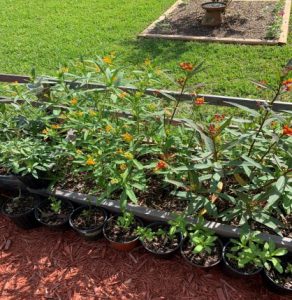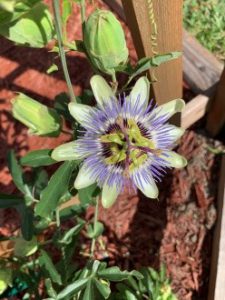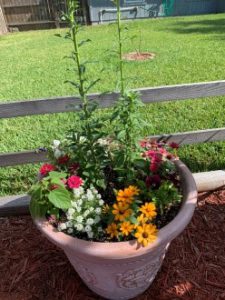Written by Lou-Ann Johanboeke
Master Gardener Volunteer
This is part 3 of a series, you can find Part 1 here and Part 2 here
Milkweeds
In the design of my garden, I worked to develop it as a Monarch Waystation. This is a garden that provides food and habitat for the monarch butterfly. The
program suggests at least two different types of milkweed. Milkweed is the host plant for the monarch larvae. I currently have at least 60 milkweed plants in my
yard. About half of them are in the actual “butterfly garden” and the others are in a bed across the yard. In addition, I keep quite a few plants in individual containers. These are used in the cage to feed the captured caterpillars.

Nectar Plants
In addition to providing the larval host plant, you need a variety of plants for nectar. Most of your garden centers will identify butterfly friendly plants on the tags. You will want flowers that bloom at various times of the year so that you have food throughout the season. Some of the plants that I currently have in my garden are:
Passion Flower (Passiflora) Salvia (Salvia divinorum)
Salvia (Salvia divinorum)
Dipladnia or Mandevilla (Mandevilla)
Zinnia (Zinnia elegans)
Purslane (Portulaca grandiflora)
Sweet Alyssum (Lobularia maritima)
Marigolds (Tagettes spp.)
Cigarette Plant (Cuphea ignea) Also known as, Cigar Flower, Firecracker Plant
Bleeding heart (Clerodendrum thomsoniae)
For more recommendations on butterfly plants, check out https://edis.ifas.ufl.edu/uw057.
Pest Control
Other considerations in a butterfly garden includes the limitation of pesticides. This can be difficult when you see your beautiful flowers and plants being eaten up by something, but you must remember if you are killing bad insects you may also killing the good ones. You certainly don’t want to kill the butterflies and pollinators.
Once I brought home 5 or 6 milkweed plants that were covered with aphids. The best thing you can do is hose them off with a strong stream of water or just squish them!
Another thing to keep in mind when buying milkweed is to ask the seller what pesticides have been used on the plants.
Seasonal Care
Lastly, you will need to be sure that you are caring for your plants by thinning, dividing, and watering so that you have good quality blooms for the monarchs. When winter comes, leave your dead stalks alone, don’t cut them back. These will provide habitat for other bugs. Plus, if you trim off the old stuff and new shoots begin to grow, they will die if a hard freeze hits. So as unsightly as they may be, leave them be.
However, remember to start cutting back all tropical milkweed plants around Thanksgiving and keep them cut back until spring. This non-native species can be a good host plant but their year-round blooming can disrupt migration and lead to a build-up of a disease that affects monarchs.
 0
0
